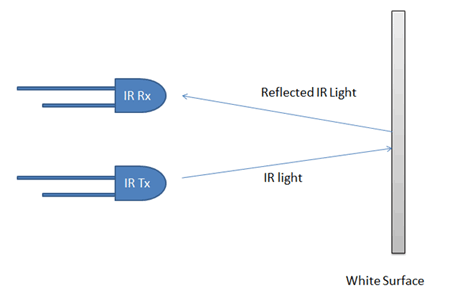Automatic Room Light Controller with Bidirectional Visitor Counter
A visitors counter is a counter which simply count the number of visitors . A visitor is counted only 1 time per day.
Often we see visitor counters at stadium, mall, offices, class rooms etc. How they count the people and turn ON or OFF the light when nobody is inside? Today we are here with automatic room light controller project with bidirectional visitor counter by using Arduino Uno. It is very interesting project for hobbist.

Code:
Often we see visitor counters at stadium, mall, offices, class rooms etc. How they count the people and turn ON or OFF the light when nobody is inside? Today we are here with automatic room light controller project with bidirectional visitor counter by using Arduino Uno. It is very interesting project for hobbist.
Components
- Arduino UNO
- Relay (5v)
- Resisters
- IR Sensor module
- 16x2 LCD display
- Bread Board
- Connecting Wires
- Led
- BC547 Transistor
The project of “Digital visitor counter”
is based on the interfacing of some components such as sensors, motors
etc. with arduino microcontroller. This counter can count people in both
directions. This circuit can be used to count the number of persons
entering a hall/mall/home/office in the entrance gate and it can count
the number of persons leaving the hall by decrementing the count at same
gate or exit gate and it depends upon sensor placement in mall/hall. It
can also be used at gates of parking areas and other public places.
This project is divided in four parts: sensors,
controller, counter display and gate. The sensor would observe an
interruption and provide an input to the controller which would run the
counter increment or decrement depending on entering or exiting of the
person. And counting is displayed on a 16x2 LCD through the controller.
When any one enters in the room, IR sensor will
get interrupted by the object then other sensor will not work because we
have added a delay for a while.

Circuit Explanation
There are some sections of whole visitor counter
circuit that are sensor section, control section, display section and
driver section.
Sensor section: In this section we have used two IR
sensor modules which contain IR diodes, potentiometer, Comparator
(Op-Amp) and LED’s. Potentiometer is used for setting reference voltage
at comparator’s one terminal and IR sensors sense the object or person
and provide a change in
voltage at comparator’s second terminal. Then
comparator compares both voltages and generates a digital signal at
output. Here in this circuit we have used two comparators for two
sensors. LM358 is used as comparator. LM358 has inbuilt two low noise
Op-amp.
Control Section: Arduino UNO is
used for controlling whole the process of this visitor counter project.
The outputs of comparators are connected to digital pin number 14 and 19
of arduino. Arduino read these signals and send commands to relay
driver circuit to drive the relay for light bulb controlling. If you
find any difficulty in working with relay, check out this tutorial on arduino relay control to learn more about operating relay with Arduino.
Display section: Display section
contains a 16x2 LCD. This section will display the counted number of
people and light status when no one will in the room.
Relay Driver section: Relay
driver section consist a BC547 transistor and a 5 volt relay for
controlling the light bulb. Transistor is used to drive the relay
because arduino does not supply enough voltage and current to drive
relay. So we added a relay driver circuit to get enough voltage and
current for relay. Arduino sends commands to this relay driver
transistor and then light bulb will turn on/off accordingly.
Visitor Counter Circuit Diagram
The outputs of IR Sensor Modules are directly
connected to arduino digital pin number 14(A0) and 19(A5). And Relay
driver transistor at digital pin 2. LCD is connected in 4 bit mode. RS
and EN pin of LCD is directly connected at 13 and 12. Data pin of LCD
D4-D7 is also directly connected to arduino at D11-D8 respectively. Rest
of connections are shown in the below circuit diagram.
Code:
#include
LiquidCrystal lcd(13,12,11,10,9,8);
#define in 14
#define out 19
#define relay 2
int count=0;
void IN()
{
count++;
lcd.clear();
lcd.print("Person In Room:");
lcd.setCursor(0,1);
lcd.print(count);
delay(1000);
}
void OUT()
{
count--;
lcd.clear();
lcd.print("Person In Room:");
lcd.setCursor(0,1);
lcd.print(count);
delay(1000);
}
void setup()
{
lcd.begin(16,2);
lcd.print("Visitor Counter");
delay(2000);
pinMode(in, INPUT);
pinMode(out, INPUT);
pinMode(relay, OUTPUT);
lcd.clear();
lcd.print("Person In Room:");
lcd.setCursor(0,1);
lcd.print(count);
}
void loop()
{
if(digitalRead(in))
IN();
if(digitalRead(out))
OUT();
if(count<=0)
{
lcd.clear();
digitalWrite(relay, LOW);
lcd.clear();
lcd.print("Nobody In Room");
lcd.setCursor(0,1);
lcd.print("Light Is Off");
delay(200);
}
else
digitalWrite(relay, HIGH);
}
LiquidCrystal lcd(13,12,11,10,9,8);
#define in 14
#define out 19
#define relay 2
int count=0;
void IN()
{
count++;
lcd.clear();
lcd.print("Person In Room:");
lcd.setCursor(0,1);
lcd.print(count);
delay(1000);
}
void OUT()
{
count--;
lcd.clear();
lcd.print("Person In Room:");
lcd.setCursor(0,1);
lcd.print(count);
delay(1000);
}
void setup()
{
lcd.begin(16,2);
lcd.print("Visitor Counter");
delay(2000);
pinMode(in, INPUT);
pinMode(out, INPUT);
pinMode(relay, OUTPUT);
lcd.clear();
lcd.print("Person In Room:");
lcd.setCursor(0,1);
lcd.print(count);
}
void loop()
{
if(digitalRead(in))
IN();
if(digitalRead(out))
OUT();
if(count<=0)
{
lcd.clear();
digitalWrite(relay, LOW);
lcd.clear();
lcd.print("Nobody In Room");
lcd.setCursor(0,1);
lcd.print("Light Is Off");
delay(200);
}
else
digitalWrite(relay, HIGH);
}






Where can one get the parts.
ReplyDelete